Storm Surge Prediction Based on Long Short-Term Memory Neural Network in the East China Sea
Abstract
:1. Introduction
2. Methods
3. Experimental Process and Result Analysis
3.1. Study Area and Data Collection
3.2. Data Processing and Model Setting
3.3. Model Evaluation
3.4. Model Results of LSTM
4. Discussion
4.1. Multiple Prediction Times of LSTM Model
4.2. Comparison with Other ML Methods
5. Conclusions
Author Contributions
Funding
Institutional Review Board Statement
Informed Consent Statement
Acknowledgments
Conflicts of Interest
References
- Berke, P.; Larsen, T.; Ruch, C. A Computer-System for Hurricane Hazard Assessment. Comput. Environ. Urban Syst. 1984, 9, 259–269. [Google Scholar] [CrossRef]
- Cyriac, R.; Dietrich, J.C.; Fleming, J.G.; Blanton, B.O.; Kaiser, C.; Dawson, C.N.; Luettich, R.A. Variability in Coastal Flooding predictions due to forecast errors during Hurricane Arthur. Coast. Eng. 2018, 137, 59–78. [Google Scholar] [CrossRef]
- Li, C.; Weeks, E.; Blanchard, B.W. Storm surge induced flux through multiple tidal passes of Lake Pontchartrain estuary during Hurricanes Gustav and Ike. Estuar. Coast. Shelf Sci. 2010, 87, 517–525. [Google Scholar] [CrossRef]
- Feng, S. Introduction to Storm Surge; Science Press: Beijing, China, 1982. [Google Scholar]
- Chen, J.; Jiang, C.; Wu, Z.; Long, Y.; Deng, B.; Liu, X. Numerical Investigation of Fresh and Salt Water Distribution in the Pearl River Estuary during a Typhoon Using a Fully Coupled Atmosphere-Wave-Ocean Model. Water 2019, 11, 646. [Google Scholar] [CrossRef] [Green Version]
- Gong, W.; Chen, Y.; Zhang, H.; Chen, Z. Effects of Wave-Current Interaction on Salt Intrusion During a Typhoon Event in a Highly Stratified Estuary. Estuaries Coasts 2018, 41, 1904–1923. [Google Scholar] [CrossRef]
- Sheng, Y.P.; Alymov, V.; Paramygin, V.A. Simulation of storm surge, wave, currents, and inundation in the Outer Banks and Chesapeake Bay during Hurricane Isabel in 2003: The importance of waves. J. Geophys. Res. Space Phys. 2010, 115, C04008. [Google Scholar] [CrossRef]
- Tajima, Y.; Lapidez, J.P.; Camelo, J.; Saito, M.; Matsuba, Y.; Shimozono, T.; Bautista, D.; Turiano, M.; Cruz, E. Post-Disaster Survey of Storm Surge and Waves Along the Coast of Batanes, the Philippines, Caused by Super Typhoon Meranti/Ferdie. Coast. Eng. J. 2017, 59, 1750009. [Google Scholar] [CrossRef] [Green Version]
- Ji, C.; Zhang, Y.; Cheng, Q.; Li, Y.; Jiang, T.; Liang, X.S. Analyzing the variation of the precipitation of coastal areas of eastern China and its association with sea surface temperature (SST) of other seas. Atmos. Res. 2019, 219, 114–122. [Google Scholar] [CrossRef]
- Ji, C.; Zhang, Y.; Cheng, Q.; Tsou, J.; Jiang, T.; Liang, X.S. Evaluating the impact of sea surface temperature (SST) on spatial distribution of chlorophyll-alpha concentration in the East China Sea. Int. J. Appl. Earth Obs. Geoinf. 2018, 68, 252–261. [Google Scholar] [CrossRef]
- Zhang, J.; Xiong, M.; Yin, C.; Gan, S. Inner shelf response to storm track variations over the east LeiZhou Peninsula, China. Int. J. Appl. Earth Obs. Geoinf. 2018, 71, 56–69. [Google Scholar] [CrossRef]
- Mei, W.; Xie, S.-P.; Primeau, F.; McWilliams, J.C.; Pasquero, C. Northwestern Pacific typhoon intensity controlled by changes in ocean temperatures. Sci. Adv. 2015, 1, e1500014. [Google Scholar] [CrossRef] [Green Version]
- Rahmstorf, S. A semi-empirical approach to projecting future sea-level rise. Science 2007, 315, 368–370. [Google Scholar] [CrossRef] [Green Version]
- Vermeer, M.; Rahmstorf, S. Global sea level linked to global temperature. Proc. Natl. Acad. Sci. USA 2009, 106, 21527–21532. [Google Scholar] [CrossRef] [PubMed] [Green Version]
- Irish, J.L.; Resio, D.T.; Ratcliff, J.J. The influence of storm size on hurricane surge. J. Phys. Oceanogr. 2008, 38, 2003–2013. [Google Scholar] [CrossRef]
- Shi, X.; Liu, S.; Yang, S.; Liu, Q.; Tan, J.; Guo, Z. Spatial-temporal distribution of storm surge damage in the coastal areas of China. Nat. Hazards 2015, 79, 237–247. [Google Scholar] [CrossRef]
- Yin, J.; Lin, N.; Yu, D. Coupled modeling of storm surge and coastal inundation: A case study in New York City during Hurricane Sandy. Water Resour. Res. 2016, 52, 8685–8699. [Google Scholar] [CrossRef]
- Sun, Z.-L.; Huang, S.-J.; Jiao, J.-G.; Nie, H.; Lu, M. Effects of cluster land reclamation projects on storm surge in Jiaojiang Estuary, China. Water Sci. Eng. 2017, 10, 59–69. [Google Scholar] [CrossRef]
- Lin, N.; Emanuel, K.A.; Smith, J.A.; Vanmarcke, E. Risk assessment of hurricane storm surge for New York City. J. Geophys. Res. Atmos. 2010, 115, D18121. [Google Scholar] [CrossRef] [Green Version]
- Yin, C.; Zhang, W.; Xiong, M.; Wang, J.; Zhou, C.; Dou, X.; Zhang, J. Storm surge responses to the representative tracks and storm timing in the Yangtze Estuary, China. Ocean. Eng. 2021, 233, 109020. [Google Scholar] [CrossRef]
- Xianwu, S.; Bingrui, C.; Jufei, Q.; Xing, K.; Tao, Y. Simulation of inundation caused by typhoon-induced probable maximum storm surge based on numerical modeling and observational data. Stoch. Environ. Res. Risk Assess. 2021, 35, 2273–2286. [Google Scholar] [CrossRef]
- Qiao, C.; Myers, A.T. Surrogate modeling of time-dependent metocean conditions during hurricanes. Nat. Hazards 2021. [Google Scholar] [CrossRef]
- Chen, R.; Zhang, W.; Wang, X. Machine Learning in Tropical Cyclone Forecast Modeling: A Review. Atmosphere 2020, 11, 676. [Google Scholar] [CrossRef]
- Maleki, F.; Ovens, K.; Najafian, K.; Forghani, B.; Reinhold, C.; Forghani, R. Overview of Machine Learning Part 1 Fundamentals and Classic Approaches. Neuroimaging Clin. 2020, 30, e17–e32. [Google Scholar] [CrossRef] [PubMed]
- Pedregosa, F.; Varoquaux, G.; Gramfort, A.; Michel, V.; Thirion, B.; Grisel, O.; Blondel, M.; Prettenhofer, P.; Weiss, R.; Dubourg, V.; et al. Scikit-learn: Machine Learning in Python. J. Mach. Learn. Res. 2011, 12, 2825–2830. [Google Scholar]
- Bruneau, N.; Polton, J.; Williams, J.; Holt, J. Estimation of global coastal sea level extremes using neural networks. Environ. Res. Lett. 2020, 15, 074030. [Google Scholar] [CrossRef]
- Santos, V.M.; Wahl, T.; Long, J.W.; Passeri, D.L.; Plant, N.G. Combining Numerical and Statistical Models to Predict Storm-Induced Dune Erosion. J. Geophys. Res. Earth Surf. 2019, 124, 1817–1834. [Google Scholar] [CrossRef]
- Ahijevych, D.; Pinto, J.O.; Williams, J.K.; Steiner, M. Probabilistic Forecasts of Mesoscale Convective System Initiation Using the Random Forest Data Mining Technique. Weather Forecast. 2016, 31, 581–599. [Google Scholar] [CrossRef]
- Kim, M.; Park, M.-S.; Im, J.; Park, S.; Lee, M.-I. Machine Learning Approaches for Detecting Tropical Cyclone Formation Using Satellite Data. Remote Sens. 2019, 11, 1195. [Google Scholar] [CrossRef] [Green Version]
- Matsuoka, D.; Nakano, M.; Sugiyama, D.; Uchida, S. Deep learning approach for detecting tropical cyclones and their precursors in the simulation by a cloud-resolving global nonhydrostatic atmospheric model. Prog. Earth Planet. Sci. 2018, 5, 80. [Google Scholar] [CrossRef] [Green Version]
- Park, M.-S.; Kim, M.; Lee, M.-I.; Im, J.; Park, S. Detection of tropical cyclone genesis via quantitative satellite ocean surface wind pattern and intensity analyses using decision trees. Remote Sens. Environ. 2016, 183, 205–214. [Google Scholar] [CrossRef]
- Wijnands, J.S.; Qian, G.Q.; Kuleshov, Y. Variable Selection for Tropical Cyclogenesis Predictive Modeling. Mon. Weather. Rev. 2016, 144, 4605–4619. [Google Scholar] [CrossRef]
- Zhang, T.; Lin, W.; Lin, Y.; Zhang, M.; Yu, H.; Cao, K.; Xue, W. Prediction of Tropical Cyclone Genesis from Mesoscale Convective Systems Using Machine Learning. Weather Forecast. 2019, 34, 1035–1049. [Google Scholar] [CrossRef]
- Zhang, W.; Fu, B.; Peng, M.S.; Li, T. Discriminating Developing versus Nondeveloping Tropical Disturbances in the Western North Pacific through Decision Tree Analysis. Weather Forecast. 2015, 30, 446–454. [Google Scholar] [CrossRef]
- Nath, S.; Kotal, S.D.; Kundu, P.K. Seasonal prediction of tropical cyclone activity over the north Indian Ocean using three artificial neural networks. Meteorol. Atmos. Phys. 2016, 128, 751–762. [Google Scholar] [CrossRef]
- Richman, M.B.; Leslie, L.M. Adaptive Machine Learning Approaches to Seasonal Prediction of Tropical Cyclones. Procedia Comput. Sci. 2012, 12, 276–281. [Google Scholar] [CrossRef] [Green Version]
- Richman, M.B.; Leslie, L.M.; Ramsay, H.A.; Klotzbach, P.J. Reducing Tropical Cyclone Prediction Errors Using Machine Learning Approaches. Procedia Comput. Sci. 2017, 114, 314–323. [Google Scholar] [CrossRef]
- Wijnands, J.S.; Shelton, K.; Kuleshov, Y. Improving the Operational Methodology of Tropical Cyclone Seasonal Prediction in the Australian and the South Pacific Ocean Regions. Adv. Meteorol. 2014, 838746. [Google Scholar] [CrossRef]
- Yip, Z.K.; Yau, M.K. Application of Artificial Neural Networks on North Atlantic Tropical Cyclogenesis Potential Index in Climate Change. J. Atmos. Ocean. Technol. 2012, 29, 1202–1220. [Google Scholar] [CrossRef]
- Giffard-Roisin, S.; Yang, M.; Charpiat, G.; Bonfanti, C.K.; Kégl, B.; Monteleoni, C. Tropical Cyclone Track Forecasting Using Fused Deep Learning From Aligned Reanalysis Data. Front. Big Data 2020, 3, 1. [Google Scholar] [CrossRef] [Green Version]
- Rüttgers, M.; Lee, S.; Jeon, S.; You, D. Prediction of a typhoon track using a generative adversarial network and satellite images. Sci. Rep. 2019, 9, 6057. [Google Scholar] [CrossRef]
- Geng, H.; Shi, D.; Zhang, W.; Huang, C. A prediction scheme for the frequency of summer tropical cyclone landfalling over China based on data mining methods. Meteorol. Appl. 2016, 23, 587–593. [Google Scholar] [CrossRef]
- Zhang, W.; Leung, Y.; Chan, J.C.L. The Analysis of Tropical Cyclone Tracks in the Western North Pacific through Data Mining. Part II: Tropical Cyclone Landfall. J. Appl. Meteorol. Clim. 2013, 52, 1417–1432. [Google Scholar] [CrossRef]
- Zhang, W.; Leung, Y.; Chan, J.C.L. The Analysis of Tropical Cyclone Tracks in the Western North Pacific through Data Mining. Part I: Tropical Cyclone Recurvature. J. Appl. Meteorol. Clim. 2013, 52, 1394–1416. [Google Scholar] [CrossRef]
- Camargo, S.J.; Robertson, A.W.; Barnston, A.G.; Ghil, M. Clustering of eastern North Pacific tropical cyclone tracks: ENSO and MJO effects. Geochem. Geophys. Geosystems 2008, 9, Q06V05. [Google Scholar] [CrossRef] [Green Version]
- Camargo, S.J.; Robertson, A.W.; Gaffney, S.J.; Smyth, P.; Ghil, M. Cluster analysis of typhoon tracks. Part I: General properties. J. Clim. 2007, 20, 3635–3653. [Google Scholar] [CrossRef]
- Camargo, S.J.; Robertson, A.W.; Gaffney, S.J.; Smyth, P.; Ghil, M. Cluster analysis of typhoon tracks. Part II: Large-scale circulation and ENSO. J. Clim. 2007, 20, 3654–3676. [Google Scholar] [CrossRef]
- Kim, H.-K.; Seo, K.-H. Cluster Analysis of Tropical Cyclone Tracks over the Western North Pacific Using a Self-Organizing Map. J. Clim. 2016, 29, 3731–3751. [Google Scholar] [CrossRef]
- Kim, H.-S.; Kim, J.-H.; Ho, C.-H.; Chu, P.-S. Pattern Classification of Typhoon Tracks Using the Fuzzy c-Means Clustering Method. J. Clim. 2011, 24, 488–508. [Google Scholar] [CrossRef]
- Ramsay, H.A.; Camargo, S.J.; Kim, D. Cluster analysis of tropical cyclone tracks in the Southern Hemisphere. Clim. Dyn. 2012, 39, 897–917. [Google Scholar] [CrossRef] [Green Version]
- Wang, Y.; Han, L.; Lin, Y.-J.; Shen, Y.; Zhang, W. A tropical cyclone similarity search algorithm based on deep learning method. Atmos. Res. 2018, 214, 386–398. [Google Scholar] [CrossRef]
- Yu, J.-H.; Zheng, Y.-Q.; Wu, Q.-S.; Lin, J.-G.; Gong, Z.-B. K-Means Clustering for Classification of the Northwestern Pacific Tropical Cyclone Tracks. J. Trop. Meteorol. 2016, 22, 127–135. [Google Scholar] [CrossRef]
- Zhang, W.; Leung, Y.; Wang, Y. Cluster analysis of post-landfall tracks of landfalling tropical cyclones over China. Clim. Dyn. 2013, 40, 1237–1255. [Google Scholar] [CrossRef]
- Chaudhuri, S.; Dutta, D.; Goswami, S.; Middey, A. Intensity forecast of tropical cyclones over North Indian Ocean using multilayer perceptron model: Skill and performance verification. Nat. Hazards 2013, 65, 97–113. [Google Scholar] [CrossRef]
- Chen, R.; Wang, X.; Zhang, W.; Zhu, X.; Li, A.; Yang, C. A hybrid CNN-LSTM model for typhoon formation forecasting. Geoinformatica 2019, 23, 375–396. [Google Scholar] [CrossRef]
- Pan, B.; Xu, X.; Shi, Z. Tropical cyclone intensity prediction based on recurrent neural networks. Electron. Lett. 2019, 55, 413–414. [Google Scholar] [CrossRef]
- Igarashi, Y.; Tajima, Y. Application of recurrent neural network for prediction of the time-varying storm surge. Coast. Eng. J. 2021, 63, 68–82. [Google Scholar] [CrossRef]
- Kim, S.; Pan, S.; Mase, H. Artificial neural network-based storm surge forecast model: Practical application to Sakai Minato, Japan. Appl. Ocean Res. 2019, 91, 101871. [Google Scholar] [CrossRef]
- Sahoo, B.; Bhaskaran, P.K. Prediction of storm surge and coastal inundation using Artificial Neural Network-A case study for 1999 Odisha Super Cyclone. Weather Clim. Extrem. 2019, 23, 100196. [Google Scholar] [CrossRef]
- Dixit, P.; Londhe, S. Prediction of extreme wave heights using neuro wavelet technique. Appl. Ocean Res. 2016, 58, 241–252. [Google Scholar] [CrossRef]
- James, S.C.; Zhang, Y.; O’Donncha, F. A machine learning framework to forecast wave conditions. Coast. Eng. 2018, 137, 1–10. [Google Scholar] [CrossRef] [Green Version]
- Kumar, N.K.; Savitha, R.; Al Mamun, A. Regional ocean wave height prediction using sequential learning neural networks. Ocean. Eng. 2017, 129, 605–612. [Google Scholar] [CrossRef]
- O’Donncha, F.; Zhang, Y.; Chen, B.; James, S.C. An integrated framework that combines machine learning and numerical models to improve wave-condition forecasts. J. Mar. Syst. 2018, 186, 29–36. [Google Scholar] [CrossRef] [Green Version]
- O’Donncha, F.; Zhang, Y.; Chen, B.; James, S.C. Ensemble model aggregation using a computationally lightweight machine-learning model to forecast ocean waves. J. Mar. Syst. 2019, 199, 103206. [Google Scholar] [CrossRef] [Green Version]
- Oh, J.; Suh, K.-D. Real-time forecasting of wave heights using EOF—wavelet—neural network hybrid model. Ocean. Eng. 2018, 150, 48–59. [Google Scholar] [CrossRef]
- Kömürcü, M.İ.; Kömür, M.A.; Akpınar, A.; Özölçer, İ.H.; Yüksek, Ö. Prediction of offshore bar-shape parameters resulted by cross-shore sediment transport using neural network. Appl. Ocean Res. 2013, 40, 74–82. [Google Scholar] [CrossRef]
- López, I.; Aragonés, L.; Villacampa, Y.; Serra, J.C. Neural network for determining the characteristic points of the bars. Ocean. Eng. 2017, 136, 141–151. [Google Scholar] [CrossRef] [Green Version]
- Pape, L.; Ruessink, B.G.; Wiering, M.A.; Turner, I.L. Recurrent neural network modeling of nearshore sandbar behavior. Neural Netw. 2007, 20, 509–518. [Google Scholar] [CrossRef] [Green Version]
- Hashemi, M.R.; Ghadampour, Z.; Neill, S.P. Using an artificial neural network to model seasonal changes in beach profiles. Ocean. Eng. 2010, 37, 1345–1356. [Google Scholar] [CrossRef]
- Güner, H.A.A.; Yüksel, Y.; Çevik, E.Ö. Longshore Sediment Transport-Field Data and Estimations Using Neural Networks, Numerical Model, and Empirical Models. J. Coast. Res. 2013, 29, 311–324. [Google Scholar] [CrossRef]
- Kabiri-Samani, A.R.; Aghaee-Tarazjani, J.; Borghei, S.M.; Jeng, D.S. Application of neural networks and fuzzy logic models to long-shore sediment transport. Appl. Soft Comput. 2011, 11, 2880–2887. [Google Scholar] [CrossRef]
- Accarino, G.; Chiarelli, M.; Fiore, S.; Federico, I.; Causio, S.; Coppini, G.; Aloisio, G. A multi-model architecture based on Long Short-Term Memory neural networks for multi-step sea level forecasting. Futur. Gener. Comput. Syst. 2021, 124, 1–9. [Google Scholar] [CrossRef]
- Bai, L.-H.; Xu, H. Accurate estimation of tidal level using bidirectional long short-term memory recurrent neural network. Ocean. Eng. 2021, 235, 108765. [Google Scholar] [CrossRef]
- Ishida, K.; Tsujimoto, G.; Ercan, A.; Tu, T.; Kiyama, M.; Amagasaki, M. Hourly-scale coastal sea level modeling in a changing climate using long short-term memory neural network. Sci. Total Environ. 2020, 720, 137613. [Google Scholar] [CrossRef] [PubMed]
- Yang, C.-H.; Wu, C.-H.; Hsieh, C.-M. Long Short-Term Memory Recurrent Neural Network for Tidal Level Forecasting. IEEE Access 2020, 8, 159389–159401. [Google Scholar] [CrossRef]
- Deka, P.C.; Prahlada, R. Discrete wavelet neural network approach in significant wave height forecasting for multistep lead time. Ocean. Eng. 2012, 43, 32–42. [Google Scholar] [CrossRef]
- Iuppa, C.; Cavallaro, L.; Giarrusso, C.; Musumeci, R.E.; Savasta, G. Coastal Flooding Risk Assessment Through Artificial Intelligence. In Proceedings of the Euro-Mediterranean Conference for Environmental Integration, Sousse, Tunisia, 10–13 October 2019; pp. 2005–2009. [Google Scholar] [CrossRef]
- Lee, T.-L. Neural network prediction of a storm surge. Ocean. Eng. 2006, 33, 483–494. [Google Scholar] [CrossRef]
- Lee, T.L.; Jeng, D.S. Application of artificial neural networks in tide-forecasting. Ocean. Eng. 2002, 29, 1003–1022. [Google Scholar] [CrossRef]
- Liang, S.; Li, M.; Sun, Z. Prediction models for tidal level including strong meteorologic effects using a neural network. Ocean. Eng. 2008, 35, 666–675. [Google Scholar] [CrossRef]
- Hochreiter, S.; Schmidhuber, J. Long short-term memory. Neural Comput. 1997, 9, 1735–1780. [Google Scholar] [CrossRef]
- Song, X.; Liu, Y.; Xue, L.; Wang, J.; Zhang, J.; Wang, J.; Jiang, L.; Cheng, Z. Time-series well performance prediction based on Long Short-Term Memory (LSTM) neural network model. J. Petrol. Sci. Eng. 2020, 186, 106682. [Google Scholar] [CrossRef]
- Yu, Y.; Si, X.S.; Hu, C.H.; Zhang, J.X. A Review of Recurrent Neural Networks: LSTM Cells and Network Architectures. Neural Comput. 2019, 31, 1235–1270. [Google Scholar] [CrossRef] [PubMed]
- Yousfi, S.; Berrani, S.-A.; Garcia, C. Contribution of recurrent connectionist language models in improving LSTM-based Arabic text recognition in videos. Pattern Recognit. 2017, 64, 245–254. [Google Scholar] [CrossRef]
- Cai, M.; Liu, J. Maxout neurons for deep convolutional and LSTM neural networks in speech recognition. Speech Commun. 2016, 77, 53–64. [Google Scholar] [CrossRef]
- Chherawala, Y.; Roy, P.P.; Cheriet, M. Combination of context-dependent bidirectional long short-term memory classifiers for robust offline handwriting recognition. Pattern Recognit. Lett. 2017, 90, 58–64. [Google Scholar] [CrossRef]
- Altché, F.; de La Fortelle, A. An LSTM Network for Highway Trajectory Prediction. In Proceedings of the 2017 IEEE 20th International Conference on Intelligent Transportation Systems (ITSC), Yokohama, Japan, 16–19 October 2017. [Google Scholar]
- Pham, T.; Tran, T.; Phung, D.; Venkatesh, S. Predicting healthcare trajectories from medical records: A deep learning approach. J. Biomed. Inform. 2017, 69, 218–229. [Google Scholar] [CrossRef]
- Chen, K.; Zhou, Y.; Dai, F.Y. A LSTM-based method for stock returns prediction: A case study of China stock market. In Proceedings of the 2015 IEEE International Conference on Big Data, Santa Clara, CA, USA, 29 October–1 November 2015; pp. 2823–2824. [Google Scholar]
- Peng, L.; Liu, S.; Liu, R.; Wang, L. Effective long short-term memory with differential evolution algorithm for electricity price prediction. Energy 2018, 162, 1301–1314. [Google Scholar] [CrossRef]
- Gers, F.A.; Schmidhuber, J.; Cummins, F. Learning to forget: Continual prediction with LSTM. Neural Comput. 2000, 12, 2451–2471. [Google Scholar] [CrossRef]
- Svozil, D.; Kvasnicka, V.; Pospichal, J. Introduction to multi-layer feed-forward neural networks. Chemom. Intell. Lab. Syst. 1997, 39, 43–62. [Google Scholar] [CrossRef]
- Bengio, Y.; Simard, P.; Frasconi, P. Learning Long-Term Dependencies with Gradient Descent Is Difficult. IEEE Trans. Neural Netw. 1994, 5, 157–166. [Google Scholar] [CrossRef]
- Liu, Y.; Sun, L.; Du, C.; Wang, X. Near-infrared prediction of edible oil frying times based on Bayesian Ridge Regression. Optik 2020, 218, 164950. [Google Scholar] [CrossRef]
- Fan, J.; Yue, W.; Wu, L.; Zhang, F.; Cai, H.; Wang, X.; Lu, X.; Xiang, Y. Evaluation of SVM, ELM and four tree-based ensemble models for predicting daily reference evapotranspiration using limited meteorological data in different climates of China. Agric. For. Meteorol. 2018, 263, 225–241. [Google Scholar] [CrossRef]
- Sultana, N.; Hossain, S.M.Z.; Abusaad, M.; Alanbar, N.; Senan, Y.; Razzak, S.A. Prediction of biodiesel production from microalgal oil using Bayesian optimization algorithm-based machine learning approaches. Fuel 2022, 309, 122184. [Google Scholar] [CrossRef]
- Jianyun, B. Numerical Simulation and Statistical Analysis of Typhoon Storm Surge along Jiangsu Province. Master’s Thesis, Yangzhou University, Jiangsu, China, 2019. [Google Scholar]
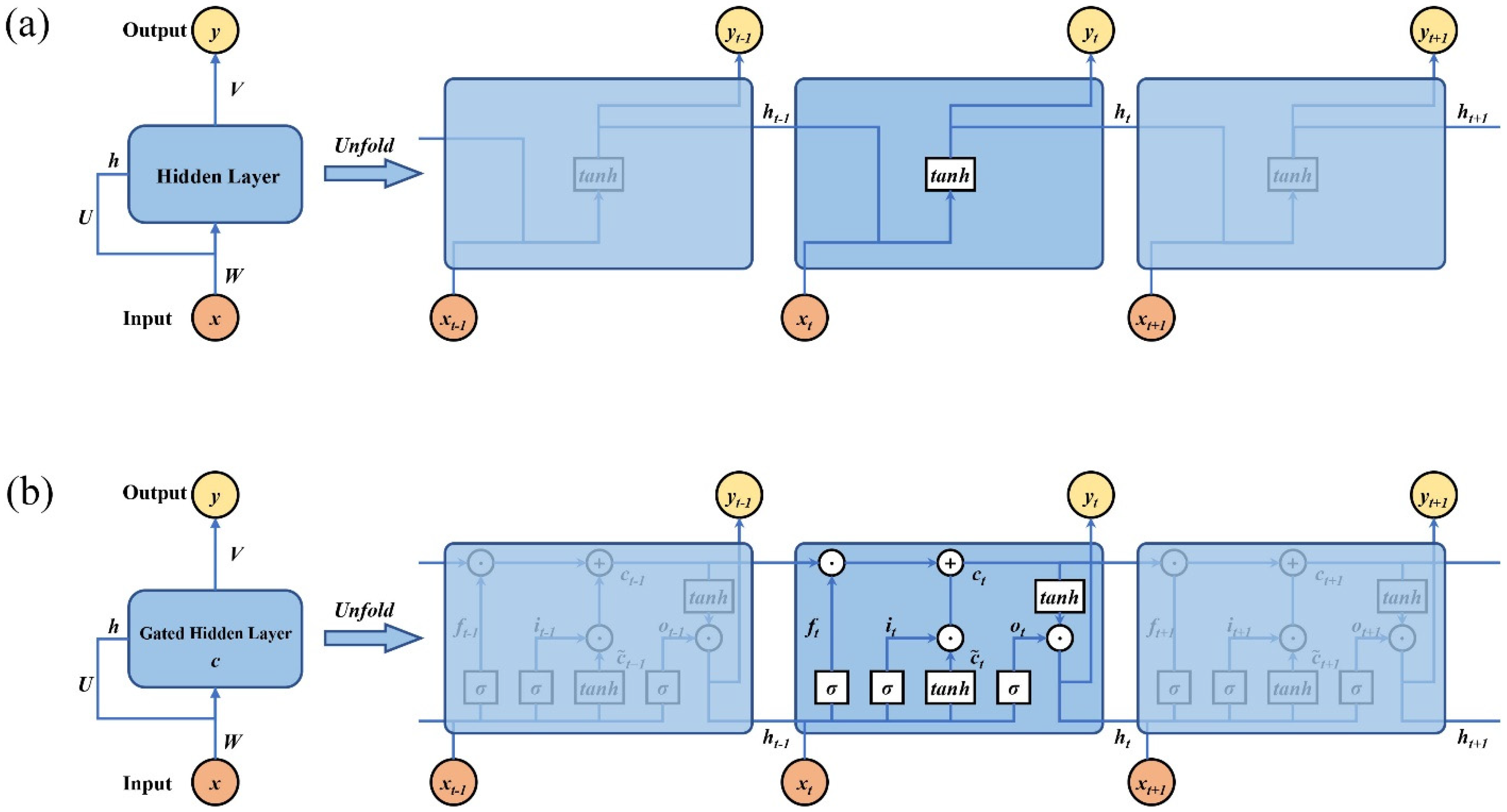
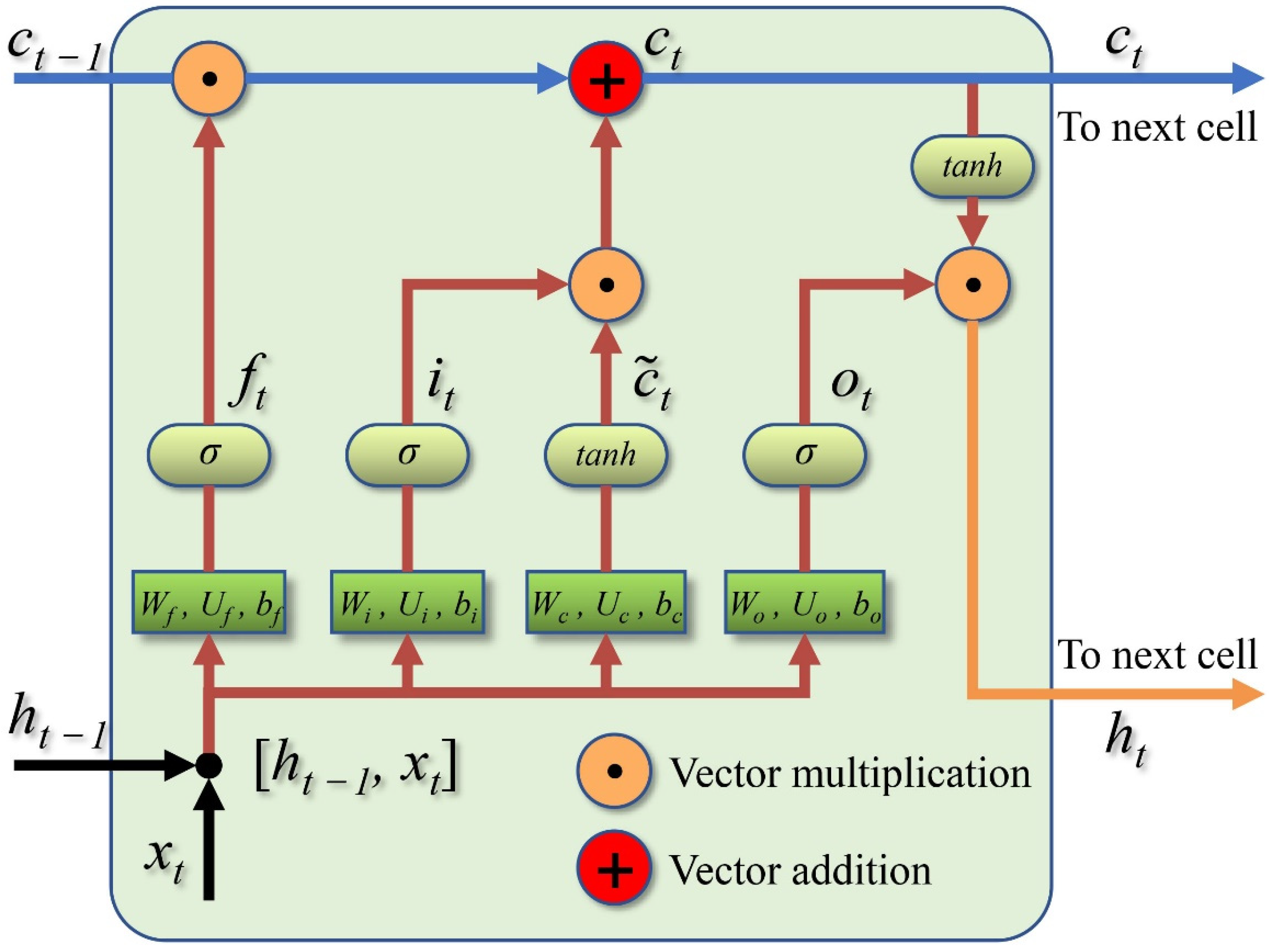
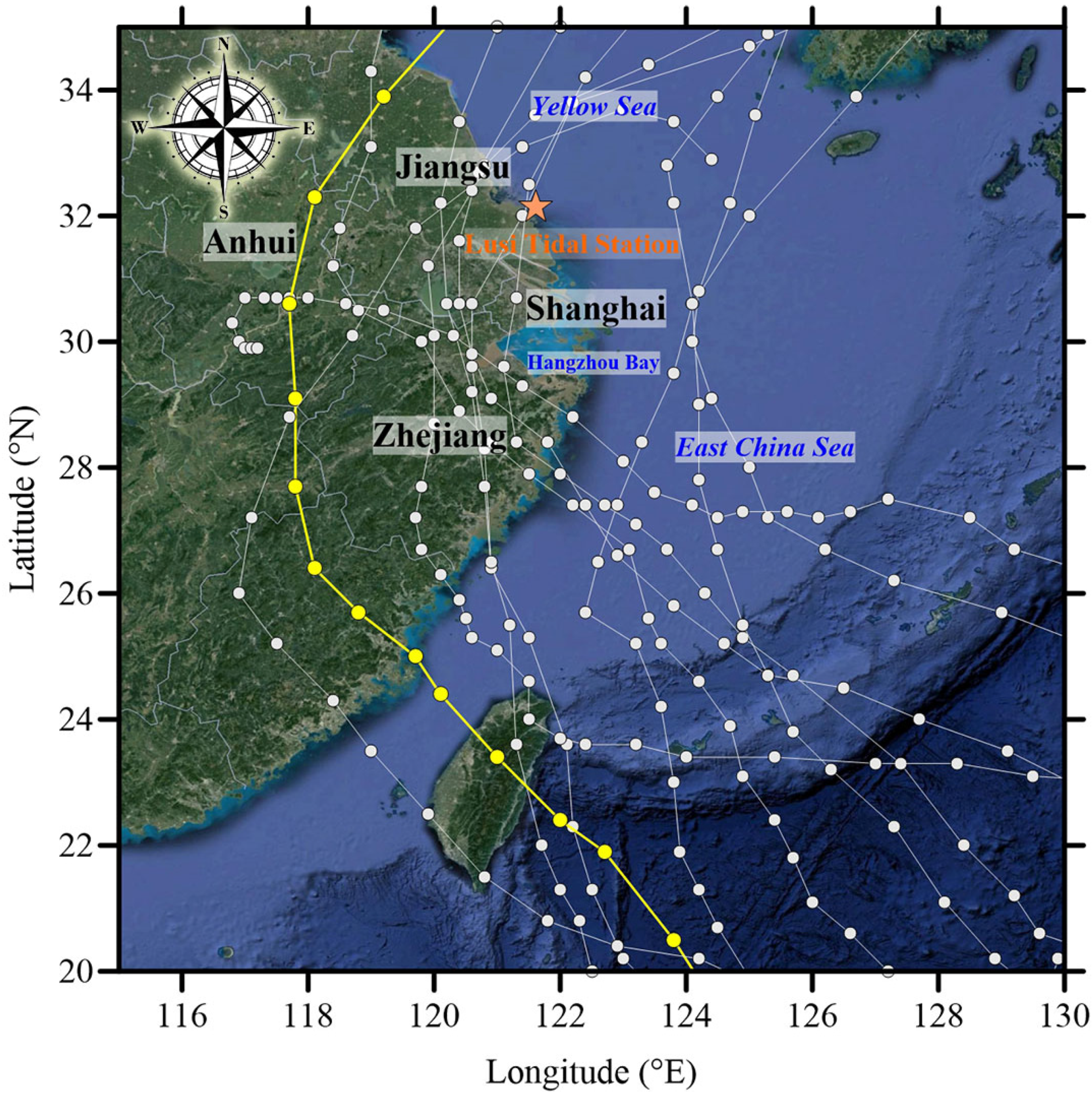
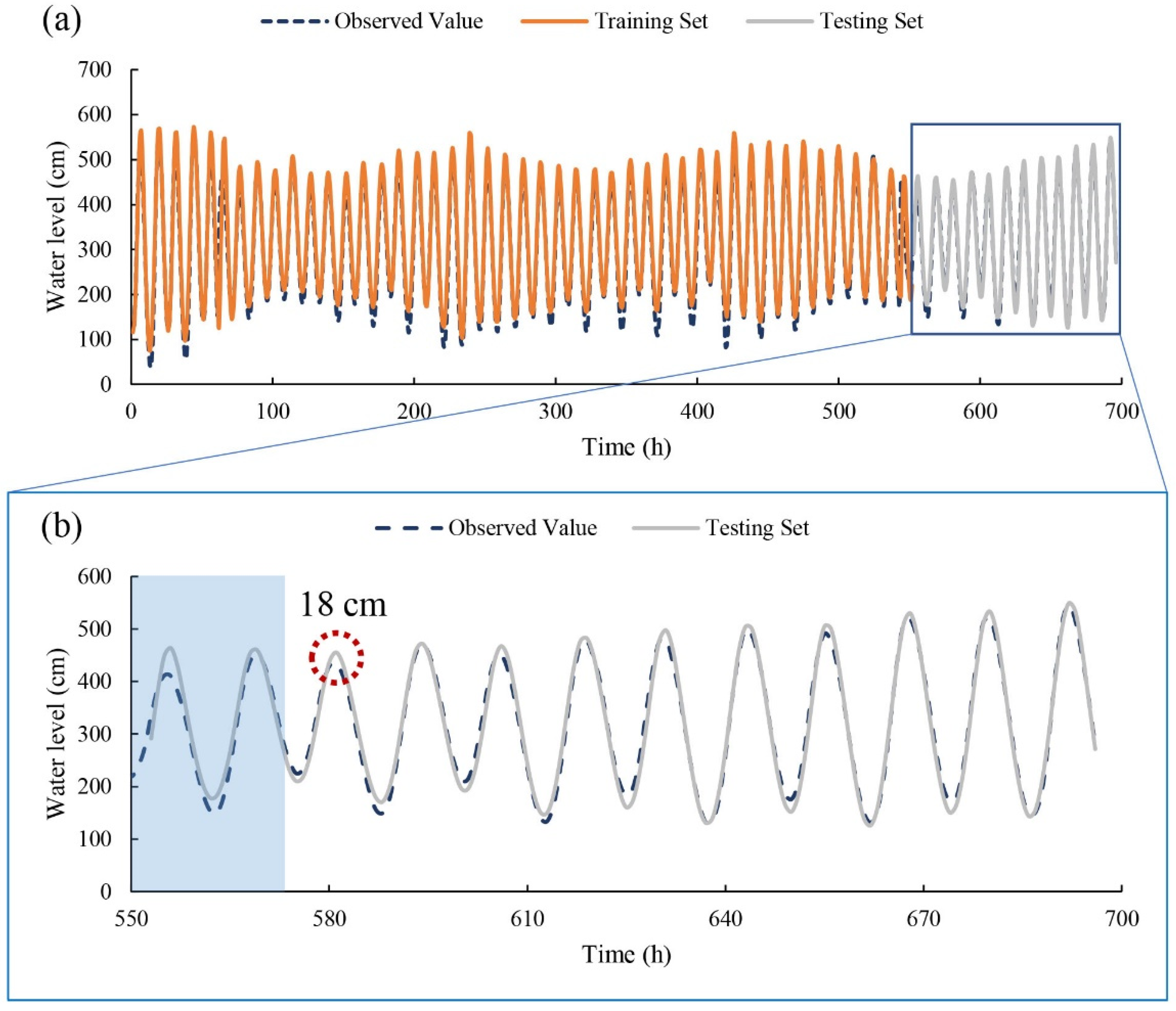
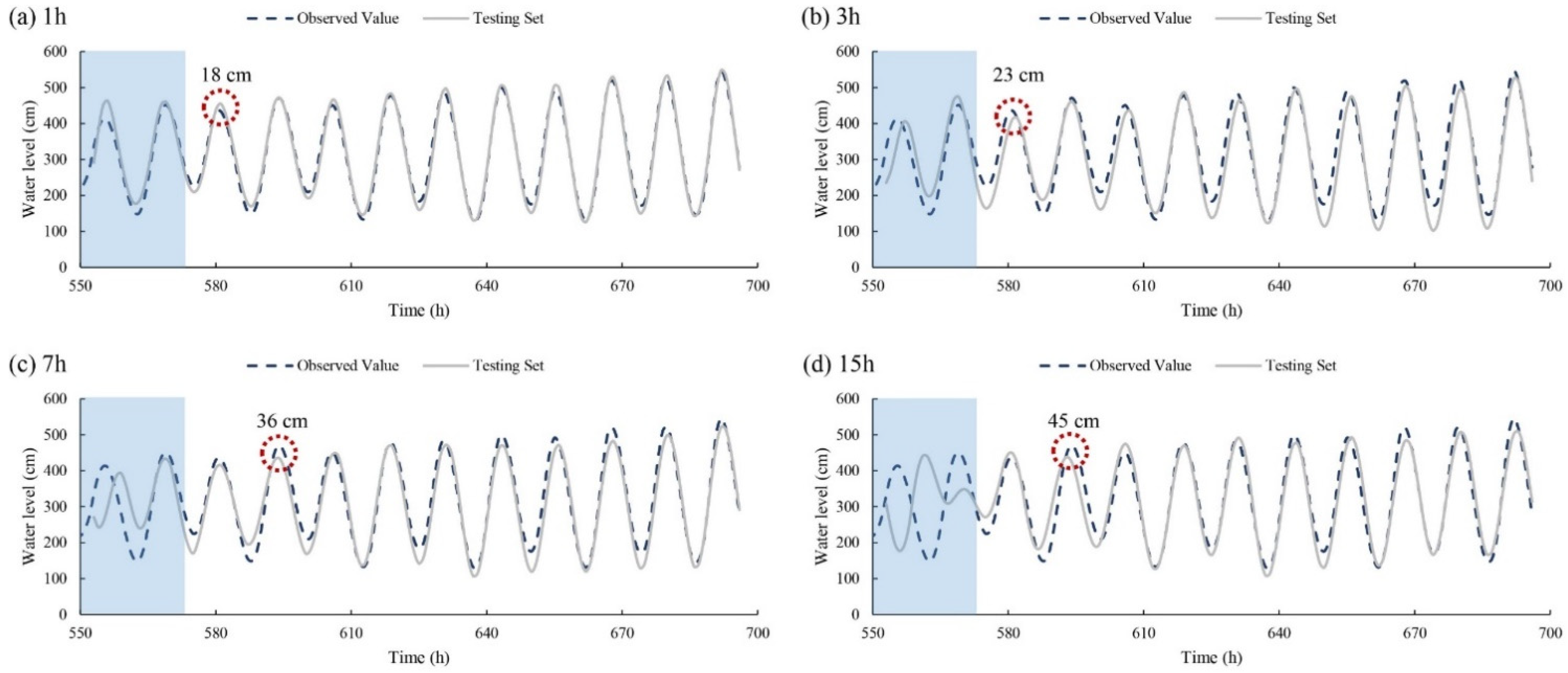
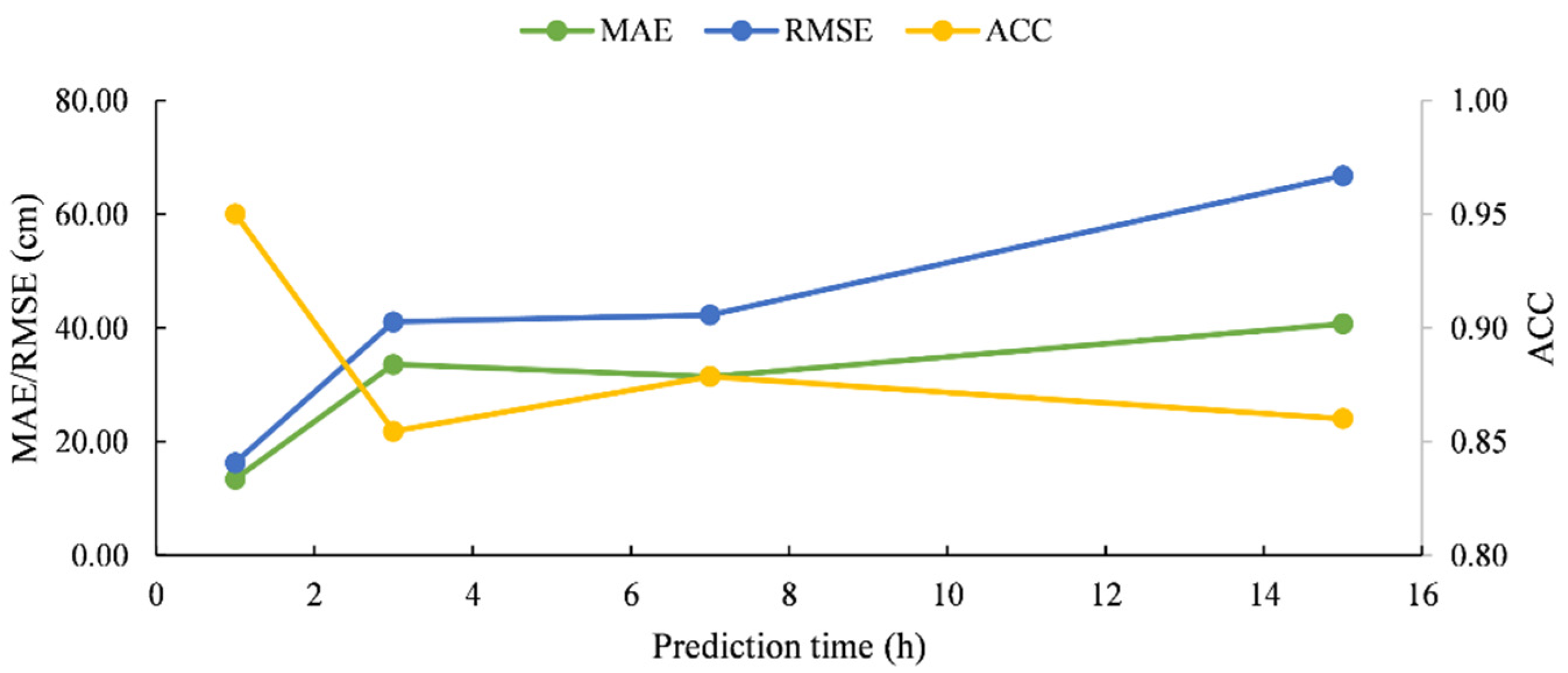
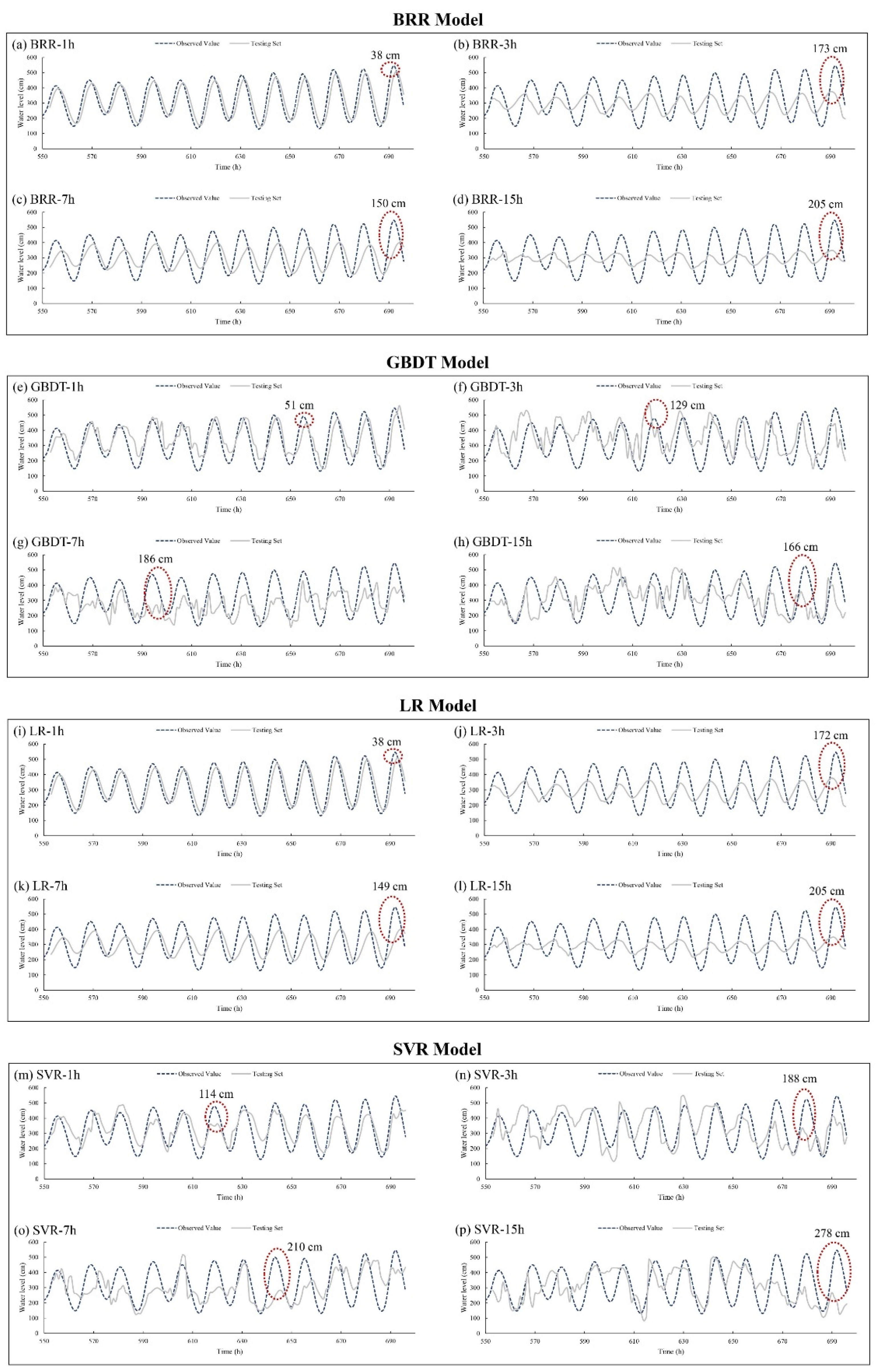

| Date | Time | Water Level (cm) | Wind Direction (°) | Wind Speed (m/s) | Atmospheric Pressure (hPa) | Typhoon Central Location | Typhoon Central Pressure (hPa) | Max Wind Speed (m/s) |
|---|---|---|---|---|---|---|---|---|
| 24 July 2014 | 0:00 | 142 | 91 | 10.8 | 995.2 | 26.1° N 118.4° E | 988 | 25 |
| 24 July 2014 | 1:00 | 214 | 102 | 11.3 | 994.2 | 26.2° N 118.1° E | 988 | 25 |
| 24 July 2014 | 2:00 | 315 | 104 | 9.3 | 993.3 | 26.4° N 118.1° E | 988 | 25 |
| 24 July 2014 | 3:00 | 411 | 105 | 10.7 | 992.2 | 26.7° N 118.1° E | 988 | 25 |
| 24 July 2014 | 4:00 | 475 | 108 | 9 | 991.5 | 27.0° N 118.0° E | 988 | 25 |
| 24 July 2014 | 5:00 | 486 | 13 | 15 | 991.3 | 27.2° N 118.0° E | 988 | 25 |
| 24 July 2014 | 6:00 | 460 | 14 | 16.2 | 991.2 | 27.5° N 118.0° E | 988 | 25 |
| 24 July 2014 | 7:00 | 408 | 354 | 15.2 | 991.3 | 27.7° N 117.9° E | 988 | 25 |
| Model Evaluation | Prediction Time | LSTM | BRR | GBDT | LR | SVR |
|---|---|---|---|---|---|---|
| MAE (cm) | 1 h | 13.40 | 48.80 | 59.52 | 48.80 | 64.08 |
| 3 h | 33.59 | 96.22 | 102.58 | 96.62 | 105.51 | |
| 7 h | 31.44 | 83.98 | 96.37 | 84.01 | 89.95 | |
| 15 h | 40.70 | 99.25 | 102.50 | 99.58 | 101.61 | |
| RMSE (cm) | 1 h | 16.28 | 56.13 | 71.14 | 56.12 | 75.45 |
| 3 h | 41.06 | 109.30 | 125.06 | 109.89 | 131.49 | |
| 7 h | 42.26 | 98.50 | 116.13 | 98.70 | 110.86 | |
| 15 h | 66.77 | 112.91 | 127.15 | 113.84 | 130.96 | |
| ACC | 1 h | 0.95 | 0.83 | 0.81 | 0.83 | 0.80 |
| 3 h | 0.85 | 0.67 | 0.70 | 0.67 | 0.66 | |
| 7 h | 0.88 | 0.71 | 0.63 | 0.71 | 0.68 | |
| 15 h | 0.86 | 0.66 | 0.65 | 0.66 | 0.61 | |
| Maximum Difference * (cm) | 1 h | 18 | 38 | 173 | 150 | 205 |
| 3 h | 23 | 51 | 129 | 186 | 166 | |
| 7 h | 36 | 38 | 172 | 149 | 205 | |
| 15 h | 45 | 114 | 188 | 210 | 278 |
Publisher’s Note: MDPI stays neutral with regard to jurisdictional claims in published maps and institutional affiliations. |
© 2021 by the authors. Licensee MDPI, Basel, Switzerland. This article is an open access article distributed under the terms and conditions of the Creative Commons Attribution (CC BY) license (https://creativecommons.org/licenses/by/4.0/).
Share and Cite
Chen, K.; Kuang, C.; Wang, L.; Chen, K.; Han, X.; Fan, J. Storm Surge Prediction Based on Long Short-Term Memory Neural Network in the East China Sea. Appl. Sci. 2022, 12, 181. https://doi.org/10.3390/app12010181
Chen K, Kuang C, Wang L, Chen K, Han X, Fan J. Storm Surge Prediction Based on Long Short-Term Memory Neural Network in the East China Sea. Applied Sciences. 2022; 12(1):181. https://doi.org/10.3390/app12010181
Chicago/Turabian StyleChen, Kuo, Cuiping Kuang, Lei Wang, Ke Chen, Xuejian Han, and Jiadong Fan. 2022. "Storm Surge Prediction Based on Long Short-Term Memory Neural Network in the East China Sea" Applied Sciences 12, no. 1: 181. https://doi.org/10.3390/app12010181
APA StyleChen, K., Kuang, C., Wang, L., Chen, K., Han, X., & Fan, J. (2022). Storm Surge Prediction Based on Long Short-Term Memory Neural Network in the East China Sea. Applied Sciences, 12(1), 181. https://doi.org/10.3390/app12010181






